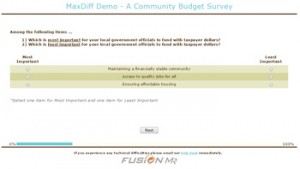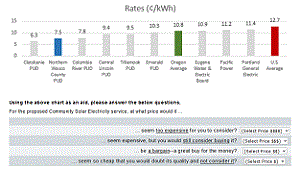Choice-Based Conjoint (Discrete Choice)
is for measuring market preference at a range of potential  price points for conceptual product or service formulations. Realistic purchase-scenario task questions (that include competitive brands) along with ‘what if’ software simulations for measuring price elasticity are major advantages of this technique. Conjoint is considered the best technique for New Product Design, Market Sizing and Brand Equity / Pricing studies.
price points for conceptual product or service formulations. Realistic purchase-scenario task questions (that include competitive brands) along with ‘what if’ software simulations for measuring price elasticity are major advantages of this technique. Conjoint is considered the best technique for New Product Design, Market Sizing and Brand Equity / Pricing studies.
MaxDiff (Maximum Differential Scaling)
is an advanced technique for determining a population’s  prioritization for a list of items. This widely applicable and scale-less technique delivers far greater between- and within-item (by segment/respondent) delineation than commonly deployed Likert scale questions. Important decisions for prioritizing budget items and determining preference for brands, features, services, products, etc. are common applications for this technique. Forcing respondents to make trade-offs is a common trait among all of these advanced survey techniques.
prioritization for a list of items. This widely applicable and scale-less technique delivers far greater between- and within-item (by segment/respondent) delineation than commonly deployed Likert scale questions. Important decisions for prioritizing budget items and determining preference for brands, features, services, products, etc. are common applications for this technique. Forcing respondents to make trade-offs is a common trait among all of these advanced survey techniques.
The Westendorp Pricing Sensitivity Meter with Newton-Miller-Smith Extension
is a simple technique for measuring a population’s  acceptance level for a new product or service. By including a wide range of price points in the test, a demand curve can later be generated. A benefit of this technique is that only six general questions are needed. However, because competitive alternatives are not included, this technique is less realistic than conjoint. It is most suitable for qualitative estimates and quantitative studies of brand new, highly differentiated, or products with little to no competition.
acceptance level for a new product or service. By including a wide range of price points in the test, a demand curve can later be generated. A benefit of this technique is that only six general questions are needed. However, because competitive alternatives are not included, this technique is less realistic than conjoint. It is most suitable for qualitative estimates and quantitative studies of brand new, highly differentiated, or products with little to no competition.
